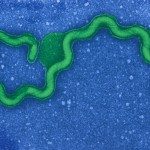Lien vers Pubmed [PMID] – 36918832
Lien DOI – 10.1186/s12879-023-08126-x
BMC Infect Dis 2023 Mar; 23(1): 157
The life-threatening pathogen Leptospira interrogans is the most common agent of leptospirosis, an emerging zoonotic disease. However, little is known about the strains that are currently circulating worldwide due to the fastidious nature of the bacteria and the difficulty to isolate cultures. In addition, the paucity of bacteria in blood and other clinical samples has proven to be a considerable challenge for directly genotyping the agent of leptospirosis directly from patient material. Our understanding of the genetic diversity of strains during human infection is therefore limited.Here, we carried out hybridization capture followed by Illumina sequencing of the core genome directly from 20 clinical samples that were PCR positive for pathogenic Leptospira to elucidate the genetic diversity of currently circulating Leptospira strains in mainland France.Capture with RNA probes covering the L. interrogans core genome resulted in a 72 to 13,000-fold increase in pathogen reads relative to standard sequencing without capture. Variant analysis of the genomes sequenced from the biological samples using 273 Leptospira reference genomes was then carried out to determine the genotype of the infecting strain. For samples with sufficient coverage (19/20 samples with coverage > 8×), we could unambiguously identify L. interrogans serovars Icterohaemorrhagiae and Copenhageni (14 samples), L. kirschneri serovar Grippotyphosa (4 samples), and L. interrogans serovar Pyrogenes (1 sample) as the infecting strains.We obtained high-quality genomic data with suitable coverage for confident core genome genotyping of the agent of leptospirosis for most of our clinical samples. The recovery of the genome of the serovars Icterohaemorrhagiae and Copenhageni directly from multiple clinical samples revealed low adaptive diversification of the core genes during human infection. The ability to generate culture-free genomic data opens new opportunities for better understanding of the epidemiology of this fastidious pathogen and pathogenesis of this neglected disease.

